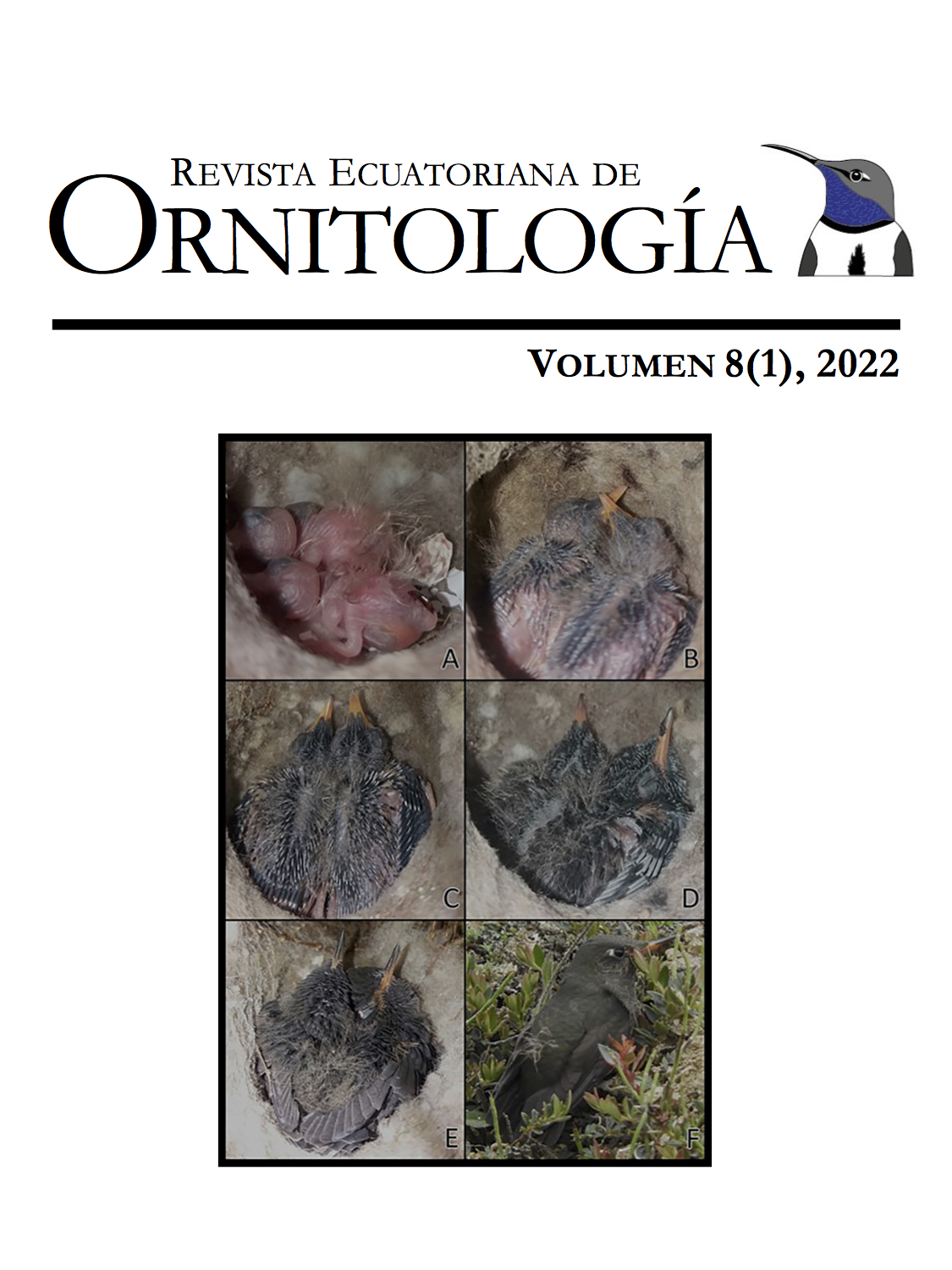CLARINERO COLIGRANDE Quiscalus mexicanus (ICTERIDAE): NOTAS SOBRE SU DIETA
DOI:
https://doi.org/10.18272/reo.v8i1.2421Palabras clave:
México; dieta; fotografía; aves urbanas; flexibilidadResumen
CLARINERO COLIGRANDE Quiscalus mexicanus (ICTERIDAE): NOTAS SOBRE SU DIETA
Descargas
Citas
Acosta-Romero, B. A., & Zuria, I. (2020). El increíble zanate mexicano: un cuento futurista. Herreriana, 1(2), 11−13. DOI: https://doi.org/10.29057/h.v1i2.5405
Christensen, A. F. (2000). The fifteenth and twentieth-century colonization of the Basin of Mexico by the Great-tailed Grackle (Quiscalus mexicanus). Global Ecology and Biogeography, 9(5), 415−420. DOI: https://doi.org/10.1046/j.1365-2699.2000.00190.x
Cupul-Magaña, F. G., & Mc Cann, F. (2016). Depredación de moluscos, crustáceos, reptiles y peces por aves en Puerto Vallarta, México: documentación fotográfica de ocho casos. Revista Ciencia y Mar, 20(59), 15−22. URL: http://cienciaymar.mx/Revista/index.php/cienciaymar/issue/view/4/ART59_2
Cupul-Magaña, F. G., Mc Cann, F., & Escobedo-Galván, A. H. (2018). Observaciones generales de la dieta del zanate mexicano Quiscalus mexicanus en Puerto Vallarta, México. Huitzil, Revista Mexicana de Ornitología, 19(1), 96−99. DOI: https://doi.org/10.28947/hrmo.2018.19.1.311
Davis, W. R. II., & Arnold, K. A. (1972). Food habits of the Great-tailed Grackle in Brazos County, Texas. Condor, 74(4), 439−446. DOI: https://doi.org/10.2307/1365896
Dean, W. R. J., Yeaton, R. I., & Milton, S. J. (2006). Foraging sites of Turkey Vultures Cathartes aura and Common Ravens Corvus corax in Central Mexico. Vulture News, 54, 30−33. DOI: https://doi.org/10.4314/vulnew.v54i1.37640
Del Villar-González, D. (2000). Principales vertebrados plaga en México: situación actual y alternativas para su manejo. Revista Chapingo Serie Ciencias Forestales y del Ambiente, 6(1), 41−54. URL: https://revistas.chapingo.mx/forestales/?section=articles&subsec=issues&numero=21&articulo=320
Dinsmore, J. J., & Dinsmore, S. J. (1993). Range expansion of the Great-tailed Grackle in the 1900s. Journal of the Iowa Academy of Science, 100(2), 54−59. URL: https://scholarworks.uni.edu/jias/vol100/iss2/4
Ducatez, S., Audet, J-N., Ros Rodriguez, J., Kayello, L., & Lefebvre, L. (2016). Innovativeness and the effects of urbanization on risk-taking behaviors in wild Barbados birds. Animal Cognition, 20, 33−42. DOI: https://doi.org/10.1007/s10071-016-1007-0
Fraga, R. (2021). Carib Grackle (Quiscalus lugubris), version 1.0. En: J. del Hoyo, A. Elliott, J. Sargatal, D. A. Christie, and E. de Juana (Eds), Birds of the World. Ithaca, NY: Cornell Lab of Ornithology. DOI: https://doi.org/10.2173/bow.cargra1.01
Frank, J. H., & Morón, M. A. (2012). Natural history of four species of Platydracus Thomson (Coleoptera: Staphylinidae) in Heliconia bourgaeana Petersen (Zingiberales: Heliconiaceae) flower bracts. Insecta Mundi, 0258, 1−12. URL: https://journals.flvc.org/mundi/article/view/0258/77982
Gurrola-Hidalgo, M. A., Sánchez-Hernández, C., & Romero-Almaraz, M. L. (2009). Dos nuevos registros de alimentación de Quiscalus mexicanus y Cyanocorax sanblasianus en la costa de Chamela, Jalisco, México. Acta Zoológica Mexicana (nueva serie), 25(2), 427−430. DOI: https://doi.org/10.21829/azm.2009.252648
Haemig, P. D. (1978). Aztec emperor Auitzotl and the Great-tailed Grackle. Biotropica, 10(1), 11-17. DOI: https://doi.org/10.2307/2388099
Haemig, P. D. (2011). Introduction of the Great-tailed Grackle by Aztec emperor Auitzotl: Four-stage analysis with new information. Ardeola, 58(2), 387-397. DOI: https://doi.org/10.13157/arla.58.2.2011.387
Hansen, M. T. (1976). A Great-tailed Grackle captures and kills a House Sparrow. Southwestern Naturalist, 21(2), 240−241. DOI: https://doi.org/10.2307/3669963
Johnson, K., & Peer, B. D. (2021). Great-tailed Grackle (Quiscalus mexicanus), version 1.0. En: A. F. Poole & F. B. Gill (Eds), Birds of the World. Ithaca, NY: Cornell Lab of Ornithology. DOI: https://doi.org/10.2173/bow.grtgra.01
Katlam, G., Prasad, S., Aggarwal, M., & Kumar, R. (2018). Trash on the menu: patterns of animal visitation and foraging behaviour at garbage dumps. Current Science, 115(12), 2322−2326. DOI: https://doi.org/10.18520/cs/v115/i12/2322-2326
Logan, C. J. (2016). Behavioral flexibility in an invasive bird is independent of other behaviors. PeerJ, 4, e2215. DOI: https://doi.org/10.3758/s13420-020-00421-w
Logan, C. J., McCune, K., MacPherson, M., Johnson-Ulrich, Z., Rowney, C., Seitz, B., Blaisdell, A. P., Deffner, D., & Wascher, C. (2021). Are the more flexible great-tailed grackles also better at behavioral inhibition? Peer Community in Ecology. URL: https://psyarxiv.com/vpc39/
Lowther, P. E., & Post, W. (2020). Shiny Cowbird (Molothrus bonariensis), version 1.0. En: S. M. Billerman (Ed), Birds of the World. Ithaca, NY: Cornell Lab of Ornithology. DOI: https://doi.org/10.2173/bow.shicow.01
Sayol, F., Maspons, J., Lapiedra, O., Iwaniuk, A. N., Székely, T., & Sol, D. (2016). Environmental variation and the evolution of large brains in birds. Nature Communications, 7, 13971. DOI: https://doi.org/10.1038/ncomms13971
Skutch, A. F. (1954). Life histories of Central American birds: Families Fringillidae, Thraupidae, Icteridae, Parulidae and Coerebidae. Pacific Coast Avifauna, 31, 1−448. DOI: https://doi.org/10.2307/4081626
Sol, D., Timmermans, S., & Lefebvre, L. (2002). Behavioural flexibility and invasion success in birds. Animal Behaviour, 63(3), 495−502. DOI: https://doi.org/10.1006/anbe.2001.1953
Sol, D., Duncan, R. P., Blackturn, T. M., Cassey, P., & Lefebvre, L. (2005). Big brains, enhanced cognition, and response of birds to novel environments. Proceedings of the National Academy of Sciences of the United States of America, 102(15), 5460−5465. DOI: https://doi.org/10.1073/pnas.0408145102
Vega-Trejo, R., Zúñiga-Vega, J. J. & Langerhans, R. B. (2014). Morphological differentiation among populations of Rhinella marina (Amphibia: Anura) in western Mexico. Evolutionary Ecolology, 28(1), 69−88. DOI: https://doi.org/10.1007/s10682-013-9667-6
Descargas
Publicado
Cómo citar
Número
Sección
Licencia
Los autores que publiquen en la Revista Ecuatoriana de Ornitología aceptan los siguientes términos:
- Los autores/as conservarán sus derechos de autor y garantizarán a la revista el derecho de primera publicación de su obra, el cuál estará simultáneamente sujeto a la Licencia de Reconocimiento No Comercial de Creative Commons.
- Los autores/as podrán adoptar otros acuerdos de licencia no exclusiva de distribución de la versión de la obra publicada, pudiendo de esa forma publicarla en un volumen monográfico o reproducirla de otras formas, siempre que se indique la publicación inicial en esta revista.
- Se permite y se recomienda a los autores difundir su obra a través de Internet en su repositorio institucional, página web personal, o red social científica (como ResearchGate o Academia.edu).



